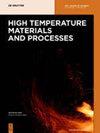组织对FH36低温钢摩擦腐蚀的影响
IF 1.5
4区 材料科学
Q4 MATERIALS SCIENCE, MULTIDISCIPLINARY
引用次数: 0
摘要
摘要低温钢的摩擦腐蚀性能对于在恶劣环境中使用至关重要。本研究旨在研究分别具有回火马氏体(TM)和回火索氏体(TS)两种不同组织的FH36低温钢的摩擦腐蚀行为。此外,还研究了这两种钢的摩擦系数、表面形貌、电化学性能和腐蚀特征。结果表明,TM钢和TS钢的冲击韧性分别为239和306 J分别为−60°C。TM钢的摩擦系数和电化学阻抗低于TS钢,而TM钢的划痕更深、更窄。在摩擦腐蚀过程中,微观结构和电化学腐蚀都会影响低温钢的耐磨性。摩擦可以加速Cl−离子的吸附,使划痕附近的凹坑富集,TM钢的点蚀严重。本文章由计算机程序翻译,如有差异,请以英文原文为准。
Effect of microstructure on tribocorrosion of FH36 low-temperature steels
Abstract The tribocorrosion performance of low-temperature steels is vital for use in hostile environments. This study aims to investigate the tribocorrosion behavior of FH36 low-temperature steel with two distinct microstructures of tempered martensite (TM) and tempered sorbite (TS), respectively. Also, the coefficient of friction, surface morphologies, electrochemical properties, and corrosion features of the two steels were investigated. The results showed that the TM and TS steel exhibited outstanding impact toughness values of 239 and 306 J at −60°C, respectively. The friction coefficient and the electrochemical impedance in the TM steel were lower than those of the TS steel, while the scratch was deeper and narrower in the TM steel. Both the microstructure and the electrochemical corrosion affect the wear resistance of the low-temperature steels during the tribocorrosion process. The friction can accelerate the adsorption of Cl− ions that enrich the pits near the scratches, and the pitting of the TM steel was severe.
求助全文
通过发布文献求助,成功后即可免费获取论文全文。
去求助
来源期刊

High Temperature Materials and Processes
工程技术-材料科学:综合
CiteScore
2.50
自引率
0.00%
发文量
42
审稿时长
3.9 months
期刊介绍:
High Temperature Materials and Processes offers an international publication forum for new ideas, insights and results related to high-temperature materials and processes in science and technology. The journal publishes original research papers and short communications addressing topics at the forefront of high-temperature materials research including processing of various materials at high temperatures. Occasionally, reviews of a specific topic are included. The journal also publishes special issues featuring ongoing research programs as well as symposia of high-temperature materials and processes, and other related research activities.
Emphasis is placed on the multi-disciplinary nature of high-temperature materials and processes for various materials in a variety of states. Such a nature of the journal will help readers who wish to become acquainted with related subjects by obtaining information of various aspects of high-temperature materials research. The increasing spread of information on these subjects will also help to shed light on relevant topics of high-temperature materials and processes outside of readers’ own core specialties.
 求助内容:
求助内容: 应助结果提醒方式:
应助结果提醒方式:


